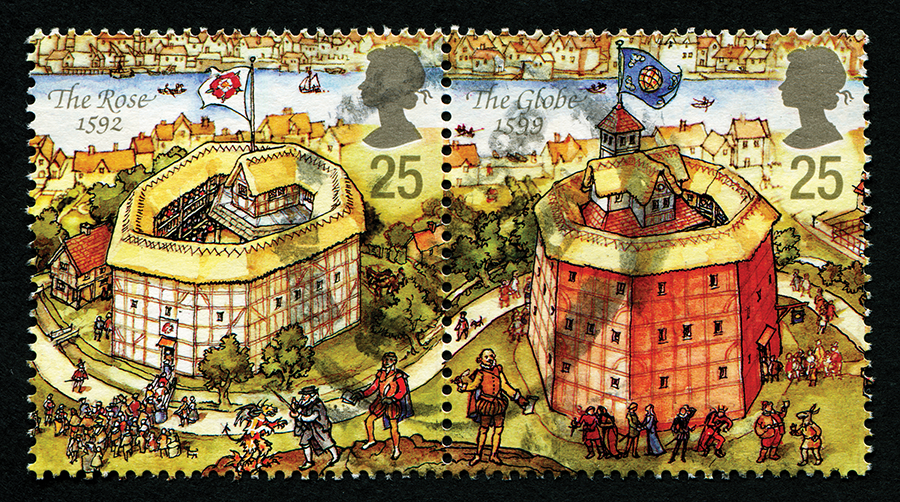
London, in the late 16th and early 17th centuries, was a bustling urban center filled with a wide variety of people and cultures. Although most life centered around making a living or going to church, the main source of diversion for Londoners was the theatre. It was a form of entertainment accessible to people of all classes. The rich and the poor, the aristocrats and the beggars, all met at the theatre, and its popularity grew enormously during the Elizabethan period. Though often appeasing the church or the monarchy, theatre at this time did experience a freedom that was unknown in previous generations. Evidence of this can be found in the numerous bawdy and pagan references found in the plays of Shakespeare, Marlowe, and others. It had taken some tenacity for theatre to thrive in London. In 1572, the city took measures to limit theatre performances in London as a measure to prevent the spread of the plague. By 1575, all players had been expelled from the walls of the city. James Burbage (father to the great Richard Burbage) saw this as an opportunity, and he built and opened London’s first playhouse just north of the city limits. It was called The Theatre. Two years later, The Curtain opened nearby. The Rose was the first theatre to open on Bankside across the Thames in 1587. It was soon joined by The Swan, and later The Globe.
THEATRE RIVALRY
The competition between rival theatre companies was great. Not only would they need to pull audiences away from other local entertainments (bear- or bull-baiting, cock-fights), brothels, taverns, and gambling but they also needed to ensure a repertory of popular pieces to keep up with the (often) six performances per week. Each theatre was looking for the next big hit. Actors and playwrights would frequently freelance with the handful of theatres, though some actors joined together to form more formal troupes, like The Admiral’s Men or The Lord Chamberlain’s Men, named for their respective patrons.
ATTENDING THE THEATRE
Performances were typically performed at two o’clock in the afternoon to take advantage of the sunlight, as there was no artificial lighting. Performances typically lasted about three hours and included a dumb-show in the beginning (a silent depiction of the events about to transpire) and ended with a bergamask dance involving the entire company. The playhouses were also at the mercy of the weather, since they were open-air. Flags would be flown above the theatres on Bankside to inform audiences that a play was to be presented that day. Elizabethan audiences would go to the theatre to “hear a play,” not “see a play” as modern audiences say. The theatrical experience was all-together different. There was limited or no scenic elements used in performances. Rather the audience was expected to use its imagination, guided by the playwright’s words and the actors’ performances. Only necessary props that helped guide the story were utilized (swords for fights, etc).
All roles in England were performed by men in Shakespeare’s day, as it was considered immoral and indecent for women to appear on stage. Women’s roles were frequently performed by boys or young men. The young lovers were often portrayed by teens before their voices changed. Even the iconic roles of Juliet, Rosalind, and Lady Macbeth, were first performed by men. Costumes in Shakespeare’s day were primarily made up of contemporary clothing that helped to denote the character’s status. Clothing was frequently donated to theatres by their patrons. Wigs, dresses, and stage make-up were used for men playing women’s roles.
THE STATUS OF ACTORS
Despite their popularity, actors maintained a relatively low social status, sometimes no better than a common beggar or rogue. Most performers were forced to earn a living doing trade work. The aristocracy’s desire for entertainment, however, did spur the development of numerous new theatre pieces. Often a nobleman would become a patron to an artist or company of actors, providing for their financial needs and sheltering them to some degree from official sanctions. In return, the company would adopt the name of the patron. Shakespeare’s acting company was originally named “Lord Chamberlain’s Men” after their patron Henry Carey, the Lord Chamberlain. Later, under the patronage of King James I, they were known as “The King’s Men,” an unprecedented honor at the time.
Special thanks to The Shakespeare Theatre of New Jersey for providing the information listed above. To view their Shakespeare in Love Education Guide, click here.
Performances of Charleston Stage’s Shakespeare in Love run April 4 – 29 at the Historic Dock Street Theatre. To purchase tickets online, click here.

